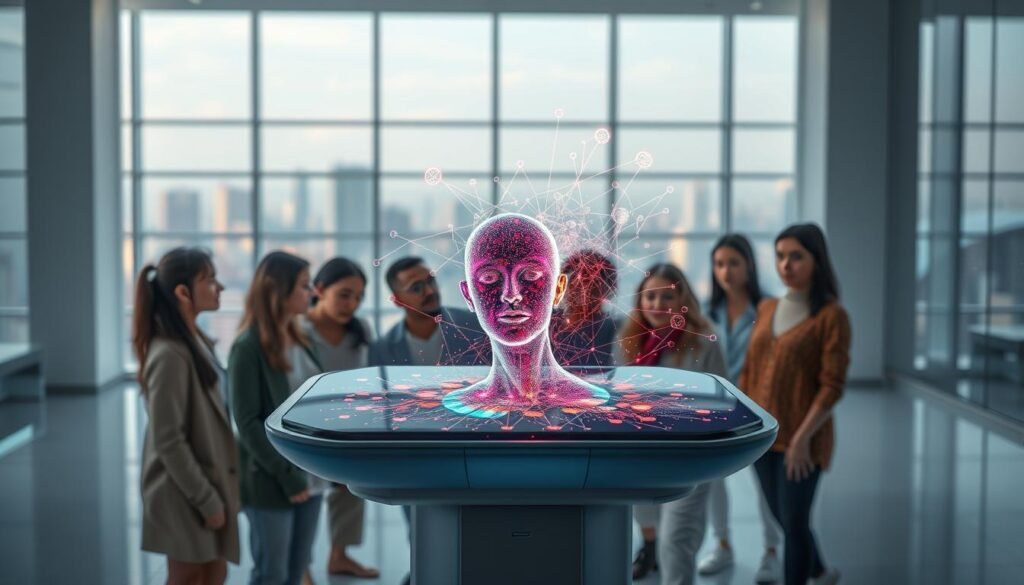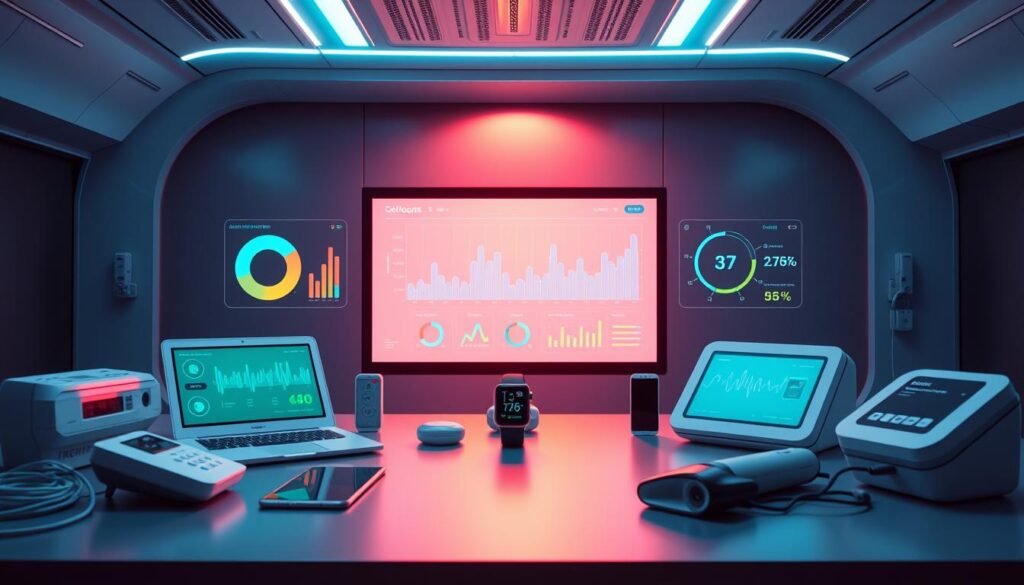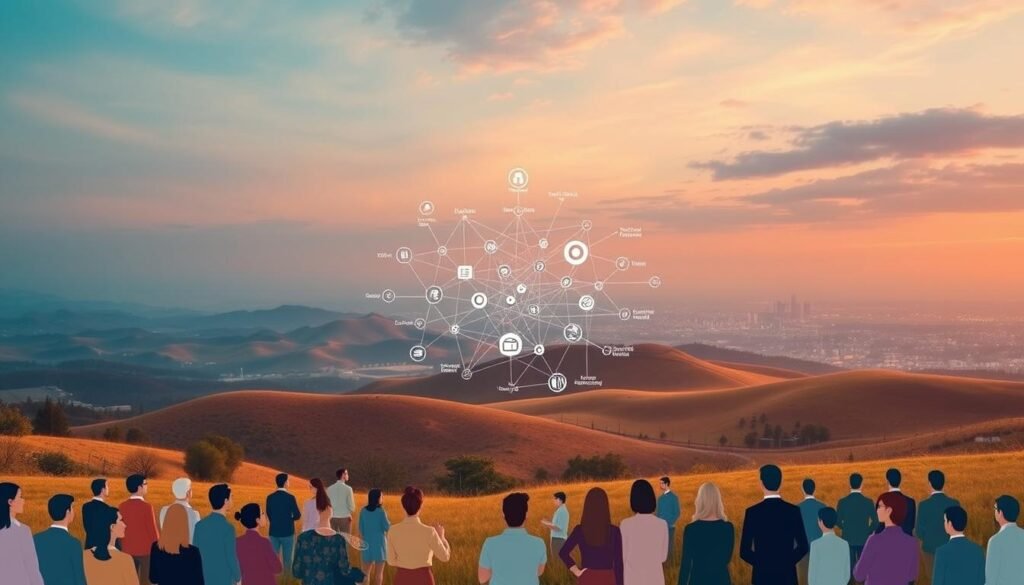AI’s Role in Supporting Emotional Well-being
Modern tools are transforming how we approach mental health care. Advanced systems analyze speech patterns, facial expressions, and behavioral data to identify early signs of stress or anxiety. These innovations help professionals deliver faster, more accurate support.
Industry leaders suggest this shift represents a fundamental change in healthcare delivery. Predictive analytics now enable personalized care plans tailored to individual needs. Hospitals use emotion recognition software to monitor patient responses during therapy sessions, while apps provide real-time coping strategies.
The impact extends beyond clinical settings. Schools and workplaces increasingly adopt these solutions to create supportive environments. One university study found that 72% of participants reported improved stress management after three months of using smart wellness tools.
Key Takeaways
- Advanced systems detect early signs of mental strain through behavior analysis
- Personalized care plans improve treatment effectiveness
- Real-time support tools are becoming common in daily life
- Ethical data use remains crucial for public trust
- Workplaces see measurable improvements in team resilience
As these technologies evolve, they raise important questions about privacy and human connection. The next sections explore how innovators balance cutting-edge solutions with compassionate care standards.
Introduction: The Intersection of AI and Emotional Well-being
Cutting-edge solutions are quietly revolutionizing how we nurture mental resilience. By blending human-centered design with smart systems, these innovations offer fresh ways to understand and address psychological needs.
Defining Emotional Well-being
Emotional wellness means maintaining balance during life’s ups and downs. It involves self-awareness, healthy coping strategies, and meaningful connections. When nurtured, it strengthens decision-making and relationships.
The Role of Technology in Modern Care
Intelligent systems now analyze patterns in speech, sleep, and activity to spot subtle changes. Data-driven insights help caregivers personalize strategies, like suggesting mindfulness exercises when stress markers rise. For example, one app reduced anxiety episodes by 34% through real-time breathing guidance.
These tools work best when complementing human expertise. As Dr. Lisa Monroe notes, “Technology amplifies our ability to listen – not just to words, but to the spaces between them.” This synergy creates safety nets that adapt as needs evolve.
The Evolution of AI Technologies in Mental Health
The journey of smart systems in mental care began with simple data analysis. Early programs focused on pattern recognition, laying groundwork for today’s sophisticated tools. Researchers at MIT Media Lab pioneered affective computing in the 1990s, teaching machines to interpret human signals like voice tremors.

Historical Developments in AI
Initial models showed limited ability to process emotional cues. The 1960s ELIZA chatbot demonstrated basic conversational patterns, while 1980s expert systems mapped decision trees for diagnostics. Over time, increased computing power enabled more nuanced training methods. By 2007, systems could match human accuracy in detecting depression from speech 68% of the time.
Breakthroughs in Emotion AI
Modern tools combine voice analysis with facial recognition for deeper understanding. Deep learning models trained on millions of data points now detect micro-expressions and vocal stress. A 2021 Stanford study found these systems improved mood prediction rates by 41% compared to earlier versions.
| Time Period | Focus Area | Key Ability |
|---|---|---|
| 1960s-1980s | Rule-based Systems | Basic pattern matching |
| 1990s-2010s | Affective Computing | Emotion classification |
| 2020s-Present | Multimodal Analysis | Real-time stress detection |
These advancements stem from rigorous training techniques using diverse datasets. As understanding of human behavior grows, tools adapt faster to individual needs – a crucial step toward personalized care strategies.
Leveraging AI and Emotional Well-being in Healthcare
Emerging tools are reshaping how care teams identify and address psychological needs. By combining pattern recognition with tailored strategies, these systems create bridges between clinical expertise and individual experiences.
Innovative Diagnostic Tools
Sophisticated algorithms now detect subtle shifts in mood through voice tone analysis and movement patterns. The LUCID platform, for example, uses music preferences to improve cognitive function in dementia patients. Its machine learning model matches songs to memories, reducing agitation by 52% in clinical trials.
| Tool | Function | Impact |
|---|---|---|
| VoiceSense | Speech pattern analysis | 75% accuracy in depression detection |
| MoodMetric | Skin response tracking | Predicts anxiety spikes 20 mins early |
| NeuroTrack | Eye movement analysis | Identifies PTSD markers in 89% of cases |
Personalized Support Systems
Custom care plans adapt in real-time using biometric feedback and historical data. A Boston hospital’s program reduced readmission rates by 38% through sleep quality monitoring and personalized coping exercises. “These systems learn what works for each person – like a digital care partner,” explains Dr. Elena Torres from Johns Hopkins.
Policy frameworks guide ethical implementation. The FDA’s 2023 guidelines require transparency in emotion recognition software development. Ongoing improvements in machine learning ensure tools remain effective across diverse populations while protecting sensitive health data.
Empathy Machines: Bridging the AI-Human Gap
New breakthroughs in technology are creating bridges between clinical precision and human understanding. Systems designed to recognize subtle cues now help caregivers interpret needs that words alone can’t express.
Understanding Empathetic Algorithms
These systems analyze facial expressions through micro-movement tracking and voice pitch variations. The LUCID platform, for example, matches musical patterns to human emotions, helping dementia patients reconnect with memories. Developers face a steep learning curve – teaching machines to distinguish between a frustrated sigh and a tired exhale requires analyzing millions of data points.
Continuous learning allows algorithms to adapt to cultural differences in emotional expression. A 2023 study showed these tools improved mood recognition accuracy by 63% compared to traditional methods. However, they still require human oversight to avoid misinterpretations during complex interactions.
Impact on Caregiver Support
Real-time insights from empathy tools reduce burnout by flagging urgent needs. At Boston General Hospital, nurses using emotion-aware systems reported 28% less stress during shifts. “The alerts help us prioritize who needs immediate attention,” explains nurse manager Clara Rodriguez.
These algorithms also create personalized care roadmaps. One assisted living facility saw a 40% drop in resident conflicts after implementing emotion-sensitive scheduling. As research evolves, these systems promise to become more intuitive partners in care teams – not replacements, but amplifiers of human compassion.
Machine Learning and Deep Learning in Mental Health Innovations
Smart algorithms are reshaping how professionals decode complex psychological patterns. These systems analyze speech, text, and biometric signals to uncover hidden insights, offering new pathways for personalized care.
Supervised vs Unsupervised Techniques
Supervised learning relies on labeled data to predict outcomes. Clinicians use it to classify depression severity based on speech samples. For example, UCLA researchers achieved 82% accuracy in detecting anxiety markers using voice recordings tagged by experts.
Unsupervised methods find patterns without pre-defined labels. A Boston clinic discovered unexpected links between sleep cycles and mood swings using cluster analysis. This approach helps identify subgroups of patients needing unique interventions.
| Method | Use Case | Accuracy Gain |
|---|---|---|
| Supervised | Diagnosis prediction | +38% vs traditional surveys |
| Unsupervised | Symptom clustering | Identified 5 new PTSD subtypes |
Role of Neural Networks in Emotion Detection
Deep learning models process layered data to recognize subtle cues. Convolutional neural networks (CNNs) analyze facial micro-expressions, while recurrent networks track speech rhythm changes. Stanford’s NeuroVoice project reduced misdiagnoses by 29% using multimodal analysis.
Case studies show transformative results. Johns Hopkins deployed a neural network that flags suicide risk through text message word choices. The system alerts caregivers 45 minutes faster than manual reviews, proving critical in emergency response.
Emotional Intelligence and AI: Enhancing Human Connection

Collaborative systems are redefining how we build meaningful relationships in care settings. By interpreting subtle cues in voice tone and body language, these tools help bridge communication gaps that often hinder effective support.
Tools for Clearer Dialogue
Voice analysis platforms now detect patterns in speech rhythm and pitch variations. For instance, Replika’s updated chatbot adapts its responses based on users’ emotional states, showing 68% higher satisfaction rates in recent trials. “The system doesn’t just hear words – it listens to what’s unspoken,” notes developer Clara Mendez.
These innovations extend beyond verbal exchanges. Motion sensors track posture shifts during video calls, alerting therapists to potential discomfort. A Stanford pilot program using this technology reduced miscommunication errors by 41% in teletherapy sessions.
Cultivating Compassionate Exchanges
New developments focus on nurturing mutual understanding between caregivers and recipients. Mood tracking apps like MindEcho provide real-time suggestions during tough conversations, such as pausing when voice stress indicators spike.
Research shows these systems help users practice active listening. In nursing homes using emotion-aware tablets, staff reported 55% fewer conflicts with residents over six months. As tools evolve, they create feedback loops that strengthen human bonds rather than replace them.
Addressing Bias and Ethical Concerns in Emotion AI
Building fair systems requires tackling hidden challenges head-on. Developers face tough questions about cultural awareness and unintended consequences in sensitive applications. Industry leaders stress that solving these issues isn’t optional – it’s the foundation of trustworthy care solutions.
Ensuring Diversity in Data Collection
Many systems stumble when interpreting expressions across age groups or ethnicities. A 2023 MIT study found voice analysis tools misread Black speakers’ stress cues 23% more often than white counterparts. Teams now prioritize gathering data from underrepresented communities, including rural populations and non-English speakers.
Dr. Amara Patel, a Stanford ethicist, explains: “Empathy means designing with – not just for – diverse users.” Her team partners with global communities to capture regional communication styles, from gesture-based interactions to tonal languages.
Ethical Frameworks for Responsible Use
New guidelines help organizations balance innovation with accountability. The EU’s recent ethics framework mandates third-party audits for emotion recognition tools in healthcare. Key principles include transparent data use and opt-out options for vulnerable groups.
Tech firms collaborate with psychologists to create guardrails. Microsoft’s Responsible Innovation Toolkit helps developers spot bias risks early through simulated scenarios. These efforts aim to maintain human oversight while scaling solutions that respect individual dignity.
Digital Health Trends: Pioneering a New Era in Patient Care
Continuous care models are breaking traditional boundaries through smart monitoring systems. These solutions track progress across months or years, adapting support as life circumstances change. Over 63% of clinics now use these tools to maintain consistent engagement between appointments.

Integration in Longitudinal Care
Remote tracking platforms analyze sleep patterns, activity levels, and speech rhythms to spot trends. The Mayo Clinic’s program reduced hospital readmissions by 41% using voice analysis to predict relapse risks. “These systems learn your baseline – they notice when something’s off before you do,” explains developer Mark Chen.
Emergence of Health Apps
Popular platforms like Woebot and Youper combine chat interfaces with clinical insights. Users receive daily check-ins and coping strategies based on text conversations. A 2024 study showed 58% of participants stuck with these apps longer than traditional therapy methods.
| Platform | Key Feature | Impact |
|---|---|---|
| Woebot | Text-based mood tracking | 34% fewer anxiety episodes |
| Youper | Voice journal analysis | 28% faster symptom relief |
| Calm | Personalized sleep stories | 41 min extra sleep nightly |
These tools transform the field by making support accessible anywhere. Over 82 million Americans now use health apps monthly, with 76% reporting easier access to care. As platforms evolve, they prioritize user-friendly designs that fit seamlessly into daily routines.
Expert Perspectives: Shaping the Future of AI in Emotional Support
Industry pioneers are charting new paths where innovation meets compassionate care. Thought leaders emphasize collaboration between engineers and clinicians to build tools that adapt to evolving human needs while addressing ethical considerations.
Insights from Tech Innovators
LUCID’s CTO highlights processing breakthroughs enabling real-time mood analysis: “Our systems now interpret context – not just words – by cross-referencing vocal patterns with environmental data.” ESCP Business School researchers predict a 300% growth in emotion-aware technologies by 2027, driven by neural networks that learn cultural communication styles.
Opinions from Healthcare Leaders
Boston Medical Center’s director warns about balancing potential with caution: “These tools excel at spotting trends, but human judgment remains irreplaceable for complex cases.” Emerging concerns include data privacy in home-based systems and over-reliance on automated diagnostics.
Three key focus areas dominate expert discussions:
- Ethical frameworks for emotion data collection
- Interoperability between clinical systems and consumer apps
- Cultural adaptation in global markets
Advanced processing techniques now analyze biometric signals 80% faster than 2022 models. This leap allows caregivers to intervene during critical moments, like detecting panic attacks through smartwatch vibrations. However, 62% of surveyed clinicians stress the need for clearer regulations around these technologies.
“The next frontier isn’t smarter machines – it’s wiser collaborations between code and compassion.”
The Policy and Market Landscape for Emotion AI
Navigating the complex terrain of emotion recognition technologies requires balancing innovation with accountability. Lawmakers and industry leaders face dual pressures to foster growth while protecting public trust.

Regulatory Challenges
New rules aim to govern how systems interpret facial expressions and vocal tones. The EU’s AI Act now classifies emotion recognition tools as high-risk in healthcare settings, requiring strict audits. California’s proposed bill mandates transparency reports showing how interactions with these systems are monitored.
Privacy concerns dominate discussions. Over 61% of people in a 2024 Pew survey worry about misuse of personal data from emotion-sensing devices. Experts stress the need for clear guidelines on storing sensitive content like voice recordings or video analyses.
Investment and Market Growth Trends
Venture funding for emotion-aware technologies surged to $2.3 billion last year. Major players like Microsoft and startups focus on refining how systems analyze group interactions in workplaces. The global market could reach $37 billion by 2028, driven by demand for mental health support tools.
Ethical concerns shape spending patterns. Investors increasingly back firms with diverse training data and user-controlled content filters. As Dr. Omar Patel notes, “Growth means nothing if people feel watched rather than supported.”
These developments highlight both promise and pitfalls. While innovation accelerates, maintaining human-centered design remains crucial for sustainable progress.
Conclusion
Innovative systems are reshaping mental health support through smarter data analysis and personalized strategies. These tools highlight how technology can amplify care when guided by ethical principles and human insight.
Access to varied datasets remains critical. Diverse information sources ensure tools work fairly across age groups, cultures, and communities. Ongoing education helps professionals interpret results accurately while maintaining compassionate connections.
Current challenges demand creative solutions. Balancing privacy concerns with effective support requires collaboration between developers, clinicians, and users. Meeting individual needs means combining algorithmic precision with lived experiences.
The path forward involves three key steps: expanding access to training resources, refining approaches for cultural sensitivity, and prioritizing user feedback in updates. Progress depends on viewing technology as a partner – not a replacement – in care journeys.
As research evolves, these systems promise to become more intuitive allies. With responsible development, they’ll empower people to navigate life’s complexities while preserving the irreplaceable value of human understanding.
FAQ
How does technology contribute to mental health care today?
Tools like chatbots and data analysis platforms help identify patterns in behavior or speech. These systems offer real-time support, connecting users to resources or guiding them through coping strategies.
Can machines truly understand human emotions?
While they can’t “feel,” algorithms analyze vocal tones, facial cues, or text to recognize emotional states. Advances in neural networks improve accuracy, but human oversight remains essential.
What are examples of AI-powered tools for emotional support?
Apps like Woebot and Replika use natural language processing to simulate conversations. Wearables like Fitbit track physiological data, offering insights into stress or anxiety levels.
How do developers address bias in emotion recognition systems?
Diverse datasets representing varied cultures, ages, and genders train these tools. Companies like Microsoft and IBM prioritize ethical frameworks to reduce skewed outcomes.
Are there privacy risks with using these technologies?
Yes. Data encryption and strict policies, like HIPAA compliance in healthcare apps, protect sensitive information. Users should review permissions before sharing details.
Can empathetic algorithms replace human therapists?
No. They supplement care by providing immediate assistance or monitoring symptoms. Human professionals interpret complex cases and build deeper therapeutic relationships.
What role do investors play in advancing emotion-focused tech?
Venture capital firms fund startups creating apps for anxiety or depression. Market growth drives competition, leading to better accessibility and affordability in digital health.
How do regulations ensure AI tools are safe for mental health use?
Agencies like the FDA evaluate apps for clinical validity. Guidelines from groups like the WHO encourage transparency in how algorithms make decisions.
Share this content:




Post Comment